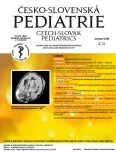Child with symptoms of acute croup at the emergency department – data analysis of children treated in 2016 and 2017
Authors:
J. Gécz 1,2; B. Valentín 1; M. Brenner 1; J. Buchanec 2
Authors‘ workplace:
Oddelenie urgentného príjmu Národného ústavu detských chorôb, Bratislava, Slovensko
1; Klinika detí a dorastu Jesseniovej lekárskej fakulty Univerzity Komenského a Univerzitnej nemocnice, Martin, Slovensko
2
Published in:
Čes-slov Pediat 2019; 74 (4): 240-243.
Category:
Original Papers
Overview
Introduction: Acute croup is a common childhood disease. It is mostly of viral etiology and if treated correctly only a small amount of children needs hospitalisation.
Objective: The major goal of our work is to evaluae the management of children with acute croup treated at the Department of paediatric emergency (DPE) in National institute of children´s diseases (NICD) in Bratislava over the years 2016 and 2017.
Material and methods: The cohort consists of every child with acute croup treated at the DPE over the years 2016 and 2017. Point of interest is the treatment (given at home, at GP´s office, ambulance or emergency department), age, sex, seasonality, severity and a further destiny of the child. We analyzed data retrospectively from medical documentation.
Results: During two years there were 1168 children with acute croup who visited DPE in NICD. Most of them were boys less than 5 years old. The incidence peaked during the winter. 31% of patients came to the ER via an ambulance. All together 95% were released home after treated at the DPE. Hospitalised were mostly children less than 6 months old and those with other complications. Dexamethasone as the choice of treat-ment was only given to 70% of children. Only a few children returned to the hospital, mostly because of incorrect treatment.
Conclusion: Acute croup is a common children´s disease. It´s treatment is well defined and evidence based medicine proves it´s efficacy. Let´s treat children correctly and minimize their hospital visits.
Keywords:
acute croup – emergency department
Sources
1. Kapellerová A, Dzurenková A. Stridor v detskom veku – príčiny a diagnóza. Pediatr prax 2008; 1 : 12–14.
2. Tuková J, Koťátko P. Akutní subglotická laryngitida. Obvyklý postup pro diagnostiku a léčbu. Praha: Česká společnost dětské pneumologie ČLS JEP, 2018. https://www.detskapneumologie.cz/getattachment/Pro-odborniky/Doporuceni-a-informace-pro-praxi/Laryngitis-acuta.pdf.aspx.
3. Sizar O, Carr B, Croup. [Updated 2019 Jan 16]. Treasure Island (FL): StatPearls Publishing; 2019 Jan. Available from: https://www.ncbi.nlm.nih.gov/books/NBK431070/.
4. Novák I. Léčba akutní subglotické laryngitidy. Pediatr pro Praxi 2007; 8 (6): 401–402.
5. Adámková V, Černá O, Doležalová Š. Akutní subglotická laryngitida. In: Frühauf P (ed). Naléhavé situace v pediatrii. Vydal GYLDEN, s.r.o., pro Nestlé Česko, s.r.o., 2014 : 22–23. ISBN 978-80-87290-04-0.
6. Penezic A, Ivkic M, Ivkic B, Baudoin T. Subglottic laryngitis – Changes in therapy approach over the past 20 years. Auris Nasus Larynx 2015 Oct; 42 (5): 390–395.
7. Ortiz-Alvarez O. Acute management of croup in the emergency department. Paediatr Child Health 2017 Jun; 22 (3): 166–173.
8.NSW Health. Infants and Children: Acute Management of Croup. 2017. https://www1.health.nsw.gov.au/pds/ActivePDSDocuments/PD2010_053.pdf.
9.South Australian Paediatric Clinical Practice Guidelines. Croup, 2018. https://www.sahealth.sa.gov.au/wps/wcm/connect/public+content/sa+health+internet/clinical+resources/clinical+topics/paediatric+clinical+guidelines.
10. Sparrow A, Geelhoed G. Prednisolone versus dexamethasone in croup: a randomised equivalence trial. Arch Dis Child 2006; 91 (7): 580–583.
11. Kawaguchi A, Joffe A. Evidence for clinicians: Nebulized epinephrine for croup in children. Paediatr Child Health 2015; 20 (8): 466.
12. Bjornson C, Russel KF, Vandermeer B. Nebulized epinephrine for croup in children. Cochrane Database of Systematic Reviews 2013, Issue 10. Art. No.: CD006619. doi: 10.1002/14651858.CD006619.pub3.
Labels
Neonatology Paediatrics General practitioner for children and adolescentsArticle was published in
Czech-Slovak Pediatrics

2019 Issue 4
Most read in this issue
- Specific aspects of posttraumatic stress disorder in childhood and adolescence
- Psychiatric disorders with predominance of somatic symptoms in childhood and adolescence
- Possibilities of pharmacotherapy of depressive disorder in children and adolescents
- The role of maternal autoantibodies in the pathogenesis of autism spectrum disorders
